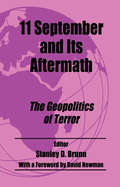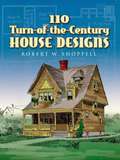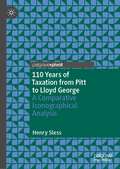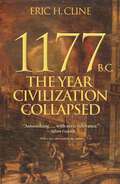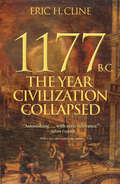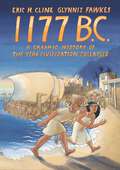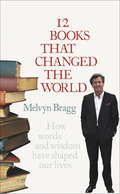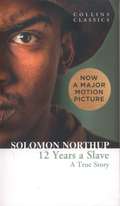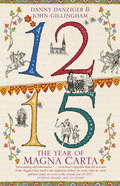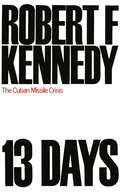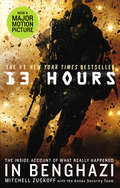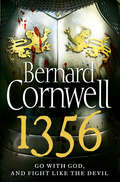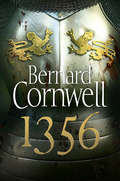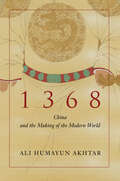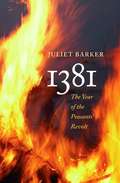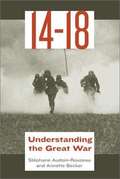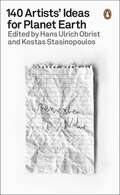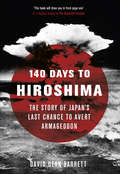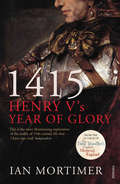- Table View
- List View
11 September and its Aftermath: The Geopolitics of Terror
by Stanley D. BrunnFirst published in 2004. Routledge is an imprint of Taylor & Francis, an informa company.
11 September and its Aftermath: The Geopolitics of Terror
by Stanley D. BrunnFirst published in 2004. Routledge is an imprint of Taylor & Francis, an informa company.
110 Turn-of-the-Century House Designs
by R. W. ShoppellWith its wealth of representative styles and its emphasis on craftsmanship and exterior design, the late-Victorian era ranks among the halcyon days in American house building. This survey of the era's traditional designs--reproduced from a rare edition--offers a complete and authentic guide to faithful restorations or re-creations.A New York City-based firm prepared and published this catalog in 1897, selecting the very best models from more than 12,000 houses built from their plans. Designed with style, utility, and low cost of construction uppermost in mind, it features hundreds of illustrations, including perspective drawings and floor plans. Details of interior and exterior materials and potential modifications include remarks on the particular amenities of each house, plus estimates of building costs. Antique collectors, home hobbyists, and fans of traditional design will find this volume a valuable reference and an endless source of inspiration.
110 Years of Taxation from Pitt to Lloyd George: A Comparative Iconographical Analysis
by Henry SlessThis book offers a multi-disciplinary visual analysis of British taxation history during the long nineteenth century. Focusing specifically on cartoons from the period, the book utilises the author’s innovative PEARL methodology to analyse the impact of Publishers’ attitudes, Editorial techniques, Artistic methods, Readers’ responses, and Legal context on historical images published in this period.The book outlines a financial and visual context for the long nineteenth century, discussing the importance of political images during a period when the relationship between the state and the taxpayer was fundamentally shifting. The state of public finance in Britain as a whole, including the growth of institutional finance, the economic impact of wars, and attempts to reduce the national debt, are considered alongside an exploration of the recurring iconographical styles of the period. The book situates the visual history of taxation within a wider context of politicised images responding to fiscal events, and uses the PEARL analysis technique to pinpoint nuanced and evolving public attitudes towards tax structures in Britain, as well as comparative developments in the US such as the impact of the Civil War and income tax debates. The book will be of interest to financial historians and academic cultural historians, as well as all those interested in visual culture and political imagery.
1177 B.C.: The Year Civilization Collapsed: Revised and Updated (Turning Points in Ancient History #1)
by Eric ClineA bold reassessment of what caused the Late Bronze Age collapseIn 1177 B.C., marauding groups known only as the "Sea Peoples" invaded Egypt. The pharaoh's army and navy managed to defeat them, but the victory so weakened Egypt that it soon slid into decline, as did most of the surrounding civilizations. After centuries of brilliance, the civilized world of the Bronze Age came to an abrupt and cataclysmic end. Kingdoms fell like dominoes over the course of just a few decades. No more Minoans or Mycenaeans. No more Trojans, Hittites, or Babylonians. The thriving economy and cultures of the late second millennium B.C., which had stretched from Greece to Egypt and Mesopotamia, suddenly ceased to exist, along with writing systems, technology, and monumental architecture. But the Sea Peoples alone could not have caused such widespread breakdown. How did it happen?In this major new account of the causes of this "First Dark Ages," Eric Cline tells the gripping story of how the end was brought about by multiple interconnected failures, ranging from invasion and revolt to earthquakes, drought, and the cutting of international trade routes. Bringing to life the vibrant multicultural world of these great civilizations, he draws a sweeping panorama of the empires and globalized peoples of the Late Bronze Age and shows that it was their very interdependence that hastened their dramatic collapse and ushered in a dark age that lasted centuries.A compelling combination of narrative and the latest scholarship, 1177 B.C. sheds new light on the complex ties that gave rise to, and ultimately destroyed, the flourishing civilizations of the Late Bronze Age—and that set the stage for the emergence of classical Greece.
1177 B.C.: The Year Civilization Collapsed (Turning Points in Ancient History)
by Eric H. ClineIn 1177 B.C., marauding groups known only as the "Sea Peoples" invaded Egypt. The pharaoh's army and navy managed to defeat them, but the victory so weakened Egypt that it soon slid into decline, as did most of the surrounding civilizations. After centuries of brilliance, the civilized world of the Bronze Age came to an abrupt and cataclysmic end. Kingdoms fell like dominoes over the course of just a few decades. No more Minoans or Mycenaeans. No more Trojans, Hittites, or Babylonians. The thriving economy and cultures of the late second millennium B.C., which had stretched from Greece to Egypt and Mesopotamia, suddenly ceased to exist, along with writing systems, technology, and monumental architecture. But the Sea Peoples alone could not have caused such widespread breakdown. How did it happen?In this major new account of the causes of this "First Dark Ages," Eric Cline tells the gripping story of how the end was brought about by multiple interconnected failures, ranging from invasion and revolt to earthquakes, drought, and the cutting of international trade routes. Bringing to life the vibrant multicultural world of these great civilizations, he draws a sweeping panorama of the empires and globalized peoples of the Late Bronze Age and shows that it was their very interdependence that hastened their dramatic collapse and ushered in a dark age that lasted centuries.A compelling combination of narrative and the latest scholarship, 1177 B.C. sheds new light on the complex ties that gave rise to, and ultimately destroyed, the flourishing civilizations of the Late Bronze Age—and that set the stage for the emergence of classical Greece.
1177 B.C.: The Year Civilization Collapsed (Turning Points in Ancient History)
by Eric H. ClineIn 1177 B.C., marauding groups known only as the "Sea Peoples" invaded Egypt. The pharaoh's army and navy managed to defeat them, but the victory so weakened Egypt that it soon slid into decline, as did most of the surrounding civilizations. After centuries of brilliance, the civilized world of the Bronze Age came to an abrupt and cataclysmic end. Kingdoms fell like dominoes over the course of just a few decades. No more Minoans or Mycenaeans. No more Trojans, Hittites, or Babylonians. The thriving economy and cultures of the late second millennium B.C., which had stretched from Greece to Egypt and Mesopotamia, suddenly ceased to exist, along with writing systems, technology, and monumental architecture. But the Sea Peoples alone could not have caused such widespread breakdown. How did it happen?In this major new account of the causes of this "First Dark Ages," Eric Cline tells the gripping story of how the end was brought about by multiple interconnected failures, ranging from invasion and revolt to earthquakes, drought, and the cutting of international trade routes. Bringing to life the vibrant multicultural world of these great civilizations, he draws a sweeping panorama of the empires and globalized peoples of the Late Bronze Age and shows that it was their very interdependence that hastened their dramatic collapse and ushered in a dark age that lasted centuries.A compelling combination of narrative and the latest scholarship, 1177 B.C. sheds new light on the complex ties that gave rise to, and ultimately destroyed, the flourishing civilizations of the Late Bronze Age—and that set the stage for the emergence of classical Greece.
1177 B.C.: A Graphic History of the Year Civilization Collapsed
by Eric H. Cline Glynnis FawkesA beautiful, full-color graphic version of Eric Cline&’s bestselling 1177 B.C., adapted by award-winning author-illustrator Glynnis FawkesEric Cline&’s 1177 B.C. tells the story of one of history&’s greatest mysteries: what caused the ancient civilizations of the Aegean and Eastern Mediterranean to collapse more than three thousand years ago, bringing the Late Bronze Age to an abrupt end? In this vivid and captivating full-color graphic adaptation of the landmark book, author-illustrator Glynnis Fawkes invites us to follow two young friends living in the aftermath of the cataclysm as they unravel why it happened—and reveal important lessons for today&’s interconnected and vulnerable world.Pel, a member of the marauding Sea Peoples, and Shesha, an Egyptian scribe, visit the kingdoms of the Minoans, Mycenaeans, Hittites, Canaanites, Assyrians, and Egyptians to explore the calamities that brought them down. This graphic history depicts the people, events, art, architecture, and lands that Pel and Shesha encounter. We witness the Sea Peoples&’ battles on land and sea, earthquakes on the Greek mainland, droughts and famine in Anatolia, invasions in north Syria, and possible rebellions in Canaan. Along the way, we also learn about the assassination of a Hittite prince traveling to marry an Egyptian queen, the sinking of a merchant ship laden with international goods, and the return of a pair of sandals to Crete by the Babylonian king Hammurabi.An entertaining adventure story, this dazzling comic is also historically accurate and enlightening, inviting readers of all ages to think about the surprising factors and theories that explain why societies, whether ancient or modern, die or survive when struck by catastrophes.
12 Books That Changed The World: How words and wisdom have shaped our lives
by Melvyn BraggWhen we think of great events in the history of the world, we tend to think of war, revolution, political upheaval or natural catastrophe. But throughout history there have been moments of vital importance that have taken place not on the battlefield, or in the palaces of power, or even in the violence of nature, but between the pages of a book. In our digitised age of instant information it is easy to underestimate the power of the printed word. In his fascinating book, Melvyn Bragg presents a vivid reminder of the book as agent of social, political and personal revolution. 12 Books that Changed the World presents a rich variety of human endeavour and a great diversity of characters. There are also surprises. Here are famous books by Darwin, Newton and Shakespeare - but we also discover the stories behind some less well-known works, such as Marie Stopes' Married Love, the original radical feminist Mary Wollstonecraft's A Vindication of the Rights of Woman - and even the rules to an obscure ball game that became the most popular sport in the world . . .
12 Years a Slave: A True Story (PDF) (Collins Classics Ser.)
by Solomon NorthupThe shocking first-hand account of one man’s remarkable fight for freedom; now an award-winning motion picture. ‘Why had I not died in my young years – before God had given me children to love and live for? What unhappiness and suffering and sorrow it would have prevented. I sighed for liberty; but the bondsman's chain was round me, and could not be shaken off.’ 1841: Solomon Northup is a successful violinist when he is kidnapped and sold into slavery. Taken from his family in New York State – with no hope of ever seeing them again – and forced to work on the cotton plantations in the Deep South, he spends the next twelve years in captivity until his eventual escape in 1853. First published in 1853, this extraordinary true story proved to be a powerful voice in the debate over slavery in the years leading up to the Civil War. It is a true-life testament of one man’s courage and conviction in the face of unfathomable injustice and brutality: its influence on the course of American history cannot be overstated.
1215: The Year Of Magna Carta
by John Gillingham Danny DanzigerOn 15 June 1215, rebel barons forced King John to meet them at Runnymede. They did not trust the King, so he was not allowed to leave until his seal was attached to the charter in front of him. This was Magna Carta. It was a revolutionary document. Never before had royal authority been so fundamentally challenged. Nearly 800 years later, two of the charter's sixty-three clauses are still a ringing expression of freedom for mankind: 'To no one will we sell, to no one will we deny or delay right or justice'. And: 'No free man shall be taken or imprisoned or in any way ruined, except by the lawful judgement of his peers or by the law of the land'. 1215 - The Year of Magna Carta explores what it was like to be alive in that momentous year. Political power struggles are interwoven with other issues - fashion, food, education, medicine, religion, sex. In many areas it was a time of innovation and change. Windmills were erected, spectacles were invented. Dozens of new towns were founded. Oxford became the first university in England, and the great cathedrals of Salisbury and Lincoln were built. Whether describing matters of state or domestic life, this is a treasure house of a book, rich in detail and full of enthralling insights into the medieval world.
124 Distinctive House Designs and Floor Plans, 1929
by National Building PublicationsAn annual publication intended as a reference work for contractors, suppliers, architects, and homeowners, the 1929 Home Builders Catalog offered a beautifully illustrated look at a variety of homes. Painstakingly reproduced from a rare edition, this volume offers old-house restorers, preservationists, and lovers of 1920s architecture an authentic view of American homes of the era.
13 Days: The Cuban Missile Crisis October 1962 (PDF)
by Robert F. KennedyThe Cuban Missile Crisis October 1962
13 Hours: The explosive true story of how six men fought a terror attack and repelled enemy forces
by Mitchell Zuckoff13 HOURS is the true account of the events of 11 September 2012, when terrorists attacked a US State Compound and a nearby CIA station in Libya, one of the most dangerous corners of the globe. On that fateful day, a team of six American security operators stationed in Benghazi fought to repel mounting enemy forces and escalating firepower, to protect the Americans stationed there, including the US Ambassador to Libya Christopher Stevens. Going beyond the call of duty, the team ignored orders to stand down and instead choked back smoke, fought wave after wave of machine-gun fire and retook the Compound, averting tragedy on a much larger scale – although four Americans would not make it out alive. Recounting the 13 hours of the now infamous attack, this personal account is both blistering and compelling, and sets the story straight about what really happened on the ground, in the streets and on the rooftops.
130 Years of Medicine in Hong Kong: From the College of Medicine for Chinese to the Li Ka Shing Faculty of Medicine
by Frank ChingThis book reviews the medical history of Hong Kong, beginning with its birth as a British colony. It introduces the origins of Hong Kong’s medical education, which began in 1887 when the London Missionary Society set up the Hong Kong College of Medicine for Chinese. When the University of Hong Kong was established in 1911, the College became its medical faculty. The faculty has gained distinction over the years for innovative surgical techniques, for discovering the SARS virus and for its contribution to advances in medical and health sciences. This book is meant for general readers as well as medical practitioners. It is a work for anyone interested in Hong Kong or in medical education.
1356: A Novel (Grail Quest)
by Bernard CornwellGo with God and Fight Like the Devil. The remarkable new novel by Britain’s master storyteller, which culminates at the Battle of Poitiers.
1356 (Special Edition): A Novel
by Bernard CornwellThis special edition Ebook features exclusive extra content by the author, with an extended Historical Note and two contemporary accounts of the Battle of Poitiers.
1368: China and the Making of the Modern World
by Ali Humayun AkhtarA new picture of China's rise since the Age of Exploration and its historical impact on the modern world. The establishment of the Great Ming dynasty in 1368 was a monumental event in world history. A century before Columbus, Beijing sent a series of diplomatic missions across the South China Sea and Indian Ocean that paved the way for China's first modern global era. 1368 maps China's ascendance from the embassies of Admiral Zheng He to the arrival of European mariners and the shock of the Opium Wars. In Ali Humayun Akhtar's new picture of world history, China's current rise evokes an earlier epoch, one that sheds light on where Beijing is heading today. Spectacular accounts in Persian and Ottoman Turkish describe palaces of silk and jade in Beijing's Forbidden City. Malay legends recount stories of Chinese princesses arriving in Melaka with gifts of porcelain and gold. During Europe's Age of Exploration, Iberian mariners charted new passages to China, which the Dutch and British East India Companies transformed into lucrative tea routes. But during the British Industrial Revolution, the rise of steam engines and factories allowed the export of the very commodities once imported from China. By the end of the Opium Wars and the arrival of Commodore Perry in Japan, Chinese and Japanese reformers called for their own industrial revolutions to propel them into the twentieth century. What has the world learned from China since the Ming, and how did China reemerge in the 1970s as a manufacturing superpower? Akhtar's book provides much-needed context for understanding China's rise today and the future of its connections with both the West and a resurgent Asia.
1368: China and the Making of the Modern World
by Ali Humayun AkhtarA new picture of China's rise since the Age of Exploration and its historical impact on the modern world. The establishment of the Great Ming dynasty in 1368 was a monumental event in world history. A century before Columbus, Beijing sent a series of diplomatic missions across the South China Sea and Indian Ocean that paved the way for China's first modern global era. 1368 maps China's ascendance from the embassies of Admiral Zheng He to the arrival of European mariners and the shock of the Opium Wars. In Ali Humayun Akhtar's new picture of world history, China's current rise evokes an earlier epoch, one that sheds light on where Beijing is heading today. Spectacular accounts in Persian and Ottoman Turkish describe palaces of silk and jade in Beijing's Forbidden City. Malay legends recount stories of Chinese princesses arriving in Melaka with gifts of porcelain and gold. During Europe's Age of Exploration, Iberian mariners charted new passages to China, which the Dutch and British East India Companies transformed into lucrative tea routes. But during the British Industrial Revolution, the rise of steam engines and factories allowed the export of the very commodities once imported from China. By the end of the Opium Wars and the arrival of Commodore Perry in Japan, Chinese and Japanese reformers called for their own industrial revolutions to propel them into the twentieth century. What has the world learned from China since the Ming, and how did China reemerge in the 1970s as a manufacturing superpower? Akhtar's book provides much-needed context for understanding China's rise today and the future of its connections with both the West and a resurgent Asia.
1381: The Year of the Peasants' Revolt
by Juliet BarkerJuliet Barker provides an account of the first great popular uprising in England and a fascinating study of medieval life in English towns and countryside. She tells how and why an unlikely group of ordinary men and women from every corner of England united in armed rebellion against church and state to demand a radical political agenda.
1381: The Year of the Peasants' Revolt
by Juliet BarkerJuliet Barker provides an account of the first great popular uprising in England and a fascinating study of medieval life in English towns and countryside. She tells how and why an unlikely group of ordinary men and women from every corner of England united in armed rebellion against church and state to demand a radical political agenda.
14 - 18: Understanding The Great War (PDF)
by Stephane Audoin-Rouzeau Annette Becker Catherine TemersonWith this brilliantly innovative book, Stéphane Audoin-Rouzeau and Annette Becker have shown that the Great War was the matrix on which all subsequent disasters of the twentieth century were formed. Three elements of the conflict, all too often neglected or denied, are identified as those that must be grasped if we are to understand the war: First, what inspired its unprecedented physical brutality, and what were the effects of tolerating such violence? Second, how did citizens of the belligerent states come to be driven by vehement nationalistic and racist impulses? Third, how did the tens of millions bereaved by the war come to terms with the agonizing pain? With its strikingly original interpretative strength and its wealth of compelling documentary evidence drawn from all sides in the conflict, 14-18: Understanding the Great War has quickly established itself as a classic in the history of modern warfare.
140 Artists’ Ideas for Planet Earth
by Hans Ulrich Obrist Kostas StasinopoulosThrough 140 drawings, thought experiments, recipes, activist instructions, gardening ideas, insurgences and personal revolutions, artists who spend their lives thinking outside the box guide you to a new worldview; where you and the planet are one.Everything here is new. We invite you to rip out pages, to hang them up at home, to draw and scribble, to cook, to meditate, to take the book to your nearest green space.Featuring Olafur Eliasson, Etel Adnan, Alexis Pauline Gumbs, Jane Fonda & Swoon, Judy Chicago, Black Quantum Futurism Collective, Vivienne Westwood, Cauleen Smith, Marina Abramovic, Karrabing Film Collective, and many more.
140 Days to Hiroshima: The Story of Japan’s Last Chance to Avert Armageddon
by David Dean BarrettDuring the closing months of the Second World War, as America’s strategic bombing campaign incinerated Japan’s cities, two military giants were locked in a death embrace of cultural differences and diplomatic intransigence. The leaders of the United States called for the ‘unconditional surrender’ of the Japanese Empire while developing history’s deadliest weapon and weighing an invasion that would have dwarfed D-Day. Their enemy responded with a last-ditch call for the suicidal resistance of every able-bodied man and woman in ‘The Decisive Battle’ for the homeland. But had Emperor Hirohito’s generals miscalculated how far the Americans had come in developing the atomic bomb? How close did President Harry Truman come to ordering the invasion of Japan? Acclaimed historian David Dean Barrett recounts the secret strategy sessions, fierce debates, looming assassinations and planned invasions that resulted in history’s first use of nuclear weapons in combat, and the ensuing chaos as the Japanese government struggled to respond to the reality of nuclear war.
1415: Henry V's Year Of Glory
by Ian MortimerHenry V is regarded as the great English hero. Lionised in his own day for his victory at Agincourt, his piety and his rigorous application of justice, he was elevated by Shakespeare into a champion of English nationalism for all future generations. But what was he really like? Does he deserve to be thought of as 'the greatest man who ever ruled England?'In Ian Mortimer's groundbreaking book, he portrays Henry in the pivotal year of his reign. Recording the dramatic events of 1415, he offers the fullest, most precise and least romanticised view we have of Henry and what he did. The result is not only a fascinating reappraisal of Henry; it brings to the fore many unpalatable truths which biographers and military historians have largely ignored. At the centre of the book is the campaign which culminated in the battle of Agincourt: a slaughter ground designed not to advance England's interests directly but to demonstrate God's approval of Henry's royal authority on both sides of the Channel.
